History

 On January 30, 1933, President Hindenburg appointed Adolf Hitler chancellor of Germany. It wasn’t because of any election, but rather by a constitutionally questionable deal dreamed up by a small group of conservative German politicians who had given up on parliamentary rule. Little did they know that they were party to appointing one of the worst dictators in history. Their attempt to return Germany to conservative authoritarian rule, backfired miserably when, within two years, Hitler and the Nazis outmaneuvered Germany’s conservative politicians to consolidate a radical Nazi dictatorship that was completely subordinate to Hitler’s personal will. I wonder if President Hindenburg wished he had never met Hitler, much less appointed him to be chancellor.
On January 30, 1933, President Hindenburg appointed Adolf Hitler chancellor of Germany. It wasn’t because of any election, but rather by a constitutionally questionable deal dreamed up by a small group of conservative German politicians who had given up on parliamentary rule. Little did they know that they were party to appointing one of the worst dictators in history. Their attempt to return Germany to conservative authoritarian rule, backfired miserably when, within two years, Hitler and the Nazis outmaneuvered Germany’s conservative politicians to consolidate a radical Nazi dictatorship that was completely subordinate to Hitler’s personal will. I wonder if President Hindenburg wished he had never met Hitler, much less appointed him to be chancellor.
Within days of taking power, the Nazis called for Germany to boycott all Jewish businesses. This unexpected anti-Jewish propaganda was the first of many. Hitler hated the Jewish people. He had no reason for his hatred. The Jewish people had done nothing to warrant Hitler’s hatred and rage. One theory is that Hitler had decided that the Jewish people were an inferior race. That is not such a new thought. It had happened before, to the African slaves in history, who had often been referred to as mud people. The Jews, as with the slaves, were treated horribly.
Another reason Hitler hated the Jewish people, was because following Germany’s loss of World War I, Hitler blamed the Jews and the communists living in Germany. He felt that they were part of a huge conspiracy against the German military. He believed that had it not been for their interference, Britain and the allies would have lost the war. Another possible reason for Hitler’s hatred of the Jews was probably jealousy. After World War I, he saw that a lot of Germans were without jobs and struggling. Instead of looking at the war as the root cause of the economic problem, he blamed the Jews for the sorry state of affairs. Because Adolf Hitler was truly insane, I’m sure that his reason to hate the Jewish people made sense to him, but the reality is that his insane mind was the only place that it made sense.
I’m not sure how he managed to get so many people to agree with is ideas, but somehow he did, and when he decided that all Jewish shops were to be boycotted, and stationed his SA Storm Troopers near the shops to 

ensure that his plans were carried out, they did as they were told. It wasn’t long after the boycotting of the shops that Hitler took things to the next level, and began hauling the Jewish people to the death camps. As long as he was alive, there was no end to his hatred, and that is definitely not what President Hindenburg or the conservative German politicians had in mind, and I’m sure they wished they had never done it.
 Yesterday was National Holocaust Remembrance Day, I started thinking about all that happened to those poor victims of the Holocaust, and because yesterday was the day that the prisoners of Auschwitz were liberated, I began to contemplate what it must have been like for them as the exited that horrible camp. My guess is that their first thought was one of thankfulness that they had actually come out alive. Going into Auschwitz, I’m sure many had hopes that it would be just a camp for prisoners of war, and that they might be treated fairly, but as their friends began to disappear, never to return, I’m sure they knew to horrific truth. This was not a prisoner of war camp, is was a death camp, and the whole goal was to experiment, torture, and kill the prisoners. The people who worked there, were given authority to do as they pleased.
Yesterday was National Holocaust Remembrance Day, I started thinking about all that happened to those poor victims of the Holocaust, and because yesterday was the day that the prisoners of Auschwitz were liberated, I began to contemplate what it must have been like for them as the exited that horrible camp. My guess is that their first thought was one of thankfulness that they had actually come out alive. Going into Auschwitz, I’m sure many had hopes that it would be just a camp for prisoners of war, and that they might be treated fairly, but as their friends began to disappear, never to return, I’m sure they knew to horrific truth. This was not a prisoner of war camp, is was a death camp, and the whole goal was to experiment, torture, and kill the prisoners. The people who worked there, were given authority to do as they pleased.
As the prisoners were taken out of the camp, I’m sure there was a mixture of feelings…relief and guilt. Relief because they had lived through one of the worst atrocities in history…and guilt, because they had lived through one of the worst atrocities in history…while so many others did not. The guilt would have been horrible. Parents who made it out, while their children did not; children who made it out, while their parents did not. They were free, but homeless. They were weary, and many were sick or dying of starvation. The experiments performed on them probably left irreparable damage to their bodies and minds. I’m sure their thoughts were racing as the walked away from the worst time in their lives.
Their futures were uncertain. They didn’t know if they would be accepted in their home country, or if they  would have to immigrate to another country to find real freedom. And I’m sure that the worst thought was the possibility that it could happen again. Once something like the holocaust happened to a people, how could they possibly trust another nation again, and yet they would, because as horrible as the Holocaust was, there were many good people, and many good nations who were completely against the atrocities that happen during those years…people and nations who would never forget what happened. The Holocaust was an atrocity beyond the ability of most human beings ability to wrap their minds around, but it was something that was impossible to forget, for those who lived it. The horror they suffered would haunt them for the rest of their lives. It would be impossible to remove the nightmare they lived from their memory.
would have to immigrate to another country to find real freedom. And I’m sure that the worst thought was the possibility that it could happen again. Once something like the holocaust happened to a people, how could they possibly trust another nation again, and yet they would, because as horrible as the Holocaust was, there were many good people, and many good nations who were completely against the atrocities that happen during those years…people and nations who would never forget what happened. The Holocaust was an atrocity beyond the ability of most human beings ability to wrap their minds around, but it was something that was impossible to forget, for those who lived it. The horror they suffered would haunt them for the rest of their lives. It would be impossible to remove the nightmare they lived from their memory.
 If you have ever watched the movie “War Games,” you might have some idea what could happen if one of the superpowers early-warning defense radar detected an unexpected missile launch. The situation could escalate quickly, and if the offending country didn’t do something to stop the missile, the superpower might have no choice but to launch a counterattack. Of course, all this seems like part of a movie, but on January 25, 1995, it was no movie trailer.
If you have ever watched the movie “War Games,” you might have some idea what could happen if one of the superpowers early-warning defense radar detected an unexpected missile launch. The situation could escalate quickly, and if the offending country didn’t do something to stop the missile, the superpower might have no choice but to launch a counterattack. Of course, all this seems like part of a movie, but on January 25, 1995, it was no movie trailer.
On that day, Russia’s early-warning defense radar detected an unexpected missile launch near Norway. The Russian military command estimated the missile to be only minutes from impact on Moscow. When I think of early-warning system, somehow giving a country’s capital just a few moments warning doesn’t seem like very much warning. Russian President Boris Yeltsin, his defense minister, and his chief of staff were informed of the missile launch. There was no time to lose. They quickly switched the nuclear command systems to combat mode, and the nuclear suitcases carried by Yeltsin and his top commander were activated for the first time in the history of the Soviet-made weapons system. Five minutes after the launch detection, the Russian command determined that the missile’s impact point would actually be outside Russia’s borders. That was good news I’m sure, but they still had a problem. Was Norway was so bold as to launch an attack? Three more minutes passed, and Yeltsin was informed that the launching was likely not part of a surprise nuclear strike by Western nuclear submarines. It was a planned launch that was not hostile. These conclusions came minutes before Yeltsin and his commanders should have ordered a nuclear response based on standard warning protocols.

Later, it was revealed that the missile, launched from Spitzbergen, Norway, was actually carrying instruments for scientific measurements. Nine days before, Norway had notified 35 countries, including Russia, of the exact details of the planned launch. The Russian Defense Ministry had received Norway’s announcement, but somehow they had neglected to inform the on-duty personnel at the early-warning center of the imminent launch. The event raised serious concerns about the quality of the former Soviet Union’s nuclear systems. And it proved that it was imperative that anyone informed of a planned scientific launch must tell all those who needed to know.
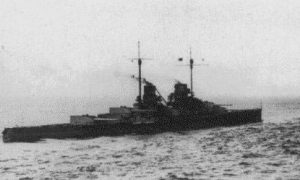 World War I, often called the Great War, not just for its epic scale but also for the sense that it was a more important and meaningful conflict than earlier European wars. One of the most legendary naval battles of the war was the Battle of Dogger Bank, which took place in the North Sea, near Dogger Bank, which is a large sandbank in a shallow area of the North Sea about 62 miles off the east coast of England, on January 24, 1915.
World War I, often called the Great War, not just for its epic scale but also for the sense that it was a more important and meaningful conflict than earlier European wars. One of the most legendary naval battles of the war was the Battle of Dogger Bank, which took place in the North Sea, near Dogger Bank, which is a large sandbank in a shallow area of the North Sea about 62 miles off the east coast of England, on January 24, 1915.
Britain was slowly bringing down the success of the submarine warfare Germany engaged in, and so a German admiral named Hipper made the tactical decision to attack three British towns on the North Sea. The first of the attacks was carried out on December 16, 1914. It was a massive shelling attack that left 18 civilians dead. The Germans deemed the grim attack a success. With that win, the Germans became more sure of themselves, and plans were made to repeat a similar attack. Unfortunately for the Germans, this time, the British Navy would be better prepared.
The Russians had captured a code book, and they shared the information with the Allies. That book allowed the 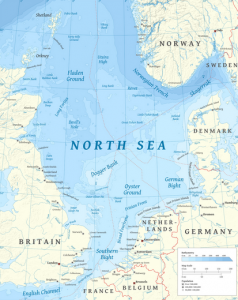 British to intercept and decode radio traffic. The information the British learned was that Hipper had set in motion plans to launch a new raid. British Admiral Beatty made a plan to beat the Germans at their own game. He took five battle cruises along with lighter cruisers and destroyers, and headed south to confront Hipper and his ships. On January 24, 1915, the that would be known as the Battle of Dogger Bank commenced. The effects of the battle were quite significant.
British to intercept and decode radio traffic. The information the British learned was that Hipper had set in motion plans to launch a new raid. British Admiral Beatty made a plan to beat the Germans at their own game. He took five battle cruises along with lighter cruisers and destroyers, and headed south to confront Hipper and his ships. On January 24, 1915, the that would be known as the Battle of Dogger Bank commenced. The effects of the battle were quite significant.
Upon sighting the British fleet, Hipper felt the numbers were too much to overcome, so he quickly ordered a retreat. Unfortunately for Hipper, the British ships were fast enough to reach him and the battle started. The German ship, Blutcher, was sunk leading to the deaths of 782 German sailors. Hipper’s ship, the Sevdlitz, suffered fatalities numbering 192. Beatty’s ship, the Lion, was left unable to fight when German attacks limited its ability to operate. It is quite likely that the British could have destroyed the entire German fleet, but Beatty worried about mines and the possible presence of submarines. Because of those worries, the German fleet was able to retreat, but it did suffer massive casualties. British casualties were relatively small, Just 15 sailors lost their lives. The British loss, while not trivial, was far less than the German losses.
While the Battle of Dogger Bank didn’t changed the overall course of the war, however, the end result of the 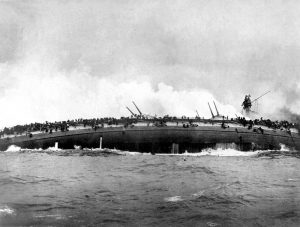 battle would have a major effect on how Germany would use its navy in engagements. Kaiser Wilhelm II decided that the navy would not take any more serious risks with its surface vessels. They knew that they were too easy to lose in a speed race. This would limit how they would be used in the war. Great Britain’s morale received a major boost following that battle. Troubling losses of military and civilian personnel had made the populace war-weary and very concerned over victory. The increase in morale had a strong effect on the troops and provided them with more resolve. In the end, Germany would lose, and the Battle of Dogger Bank had played a major part in that win. Of course, being able to break the code book, was the main reason for the win.
battle would have a major effect on how Germany would use its navy in engagements. Kaiser Wilhelm II decided that the navy would not take any more serious risks with its surface vessels. They knew that they were too easy to lose in a speed race. This would limit how they would be used in the war. Great Britain’s morale received a major boost following that battle. Troubling losses of military and civilian personnel had made the populace war-weary and very concerned over victory. The increase in morale had a strong effect on the troops and provided them with more resolve. In the end, Germany would lose, and the Battle of Dogger Bank had played a major part in that win. Of course, being able to break the code book, was the main reason for the win.

 National Handwriting Day was established in 1977, and because of John Hancock’s birthday, January 23rd, and the fact that he was a signer of the Declaration of Independence, it was decided that his birthday would be the ideal day for this unique holiday. The day was started as a way to re-introduce people to the pen and paper. In a world where most writing is done by computer, and notes are in a smartphone, the idea of writing on paper has almost become strange. I think about my Uncle Bill Spencer, the genealogy patriarch of the Spencer family, and how important handwritten letters always were to him, and I can understand how this lost art was so heartbreaking for him. When I look at treasures we have found that contain the handwriting of our parents or grandparents, it definitely brings us closer to them. At least it makes us feel closer to them.
National Handwriting Day was established in 1977, and because of John Hancock’s birthday, January 23rd, and the fact that he was a signer of the Declaration of Independence, it was decided that his birthday would be the ideal day for this unique holiday. The day was started as a way to re-introduce people to the pen and paper. In a world where most writing is done by computer, and notes are in a smartphone, the idea of writing on paper has almost become strange. I think about my Uncle Bill Spencer, the genealogy patriarch of the Spencer family, and how important handwritten letters always were to him, and I can understand how this lost art was so heartbreaking for him. When I look at treasures we have found that contain the handwriting of our parents or grandparents, it definitely brings us closer to them. At least it makes us feel closer to them.
The Writing Instrument Manufacturers Association, looks at National Handwriting Day as a chance for everyone to re-explore the purity and power of handwriting. Of course, their true motive is to promote the consumption of pens, pencils, and writing paper, but that isn’t the worst thing in the world. While this holiday was invented during the 1970s, it is considered to be a holiday that is increasing in importance with the passing of each year, because the art of handwriting is gradually being lost as more and more people use computers, tablets, and phones to email, instant message, and text their thoughts. Some believe that handwriting is as unique to a person as a fingerprint. I agree, because when I look at a handwritten note from someone I know, I can usually tell you who wrote it.
The ancient Romans were the first to develop a written script for correspondence based on aspects they borrowed from the Etruscan alphabet. However, after the Roman Empire fell, the development handwriting would come to rest with various monasteries. The problem with that is that with so many styles, people couldn’t read or understand what other people wrote…until the 8th century, when Charlemagne decided to put an English monk in charge of standardizing a handwriting script. The resulting script, Carolingian minuscule, was one that featured lowercase letters and punctuation and was designed to be easily read by candlelight. And it was a script that was highly used up until the 15th century.
During the 15th century, Johannes Gutenberg came up with a denser style of writing script for use on printed parchments and in books. This Gothic script was used extensively on his printing press, but was not really very popular with the people. Finally, Italian humanists decided to go back to a Carolingian script and then invented a cursive form of it that would eventually become known as italic. From that point on, penmanship was seen as a symbol of status. The schools began education young scholars in its use during the 18th century. The mid-19th century in the United States, brought a cursive writing system developed by my 3rd cousin 5 times removed, Platt Rogers Spencer. His penmanship style became known as the Spencerian Method. It was widely taught and many schools quickly adopted its use, but it was eventually replaced by the Palmer Method, invented by Austin Norman Palmer, at the turn of the century. The Palmer Method would eventually be replaced by the D’Nealian script, invented by Donald Thurber. It was introduced into American schools in the late 1970s.
Unfortunately, handwriting began to decline during the 1980s. Typewriters and word processors were used for writing instead of a pen and paper. We all thought it was the wave of the future, and the advance of the technological age, but I wonder if we somehow missed the bigger picture. Schools began to eliminate handwriting courses, replacing them with typewriting and eventually computer classes, and the art of 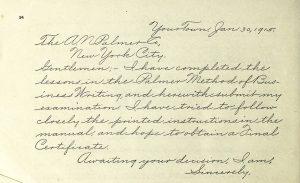
 handwriting got lost in the excitement of something new. Now, it is in serious danger of disappearing altogether. As I contemplate the end of such an important part of history, and think of my Uncle Bill, and his understanding of its real importance, I realize just how big that loss really is.
handwriting got lost in the excitement of something new. Now, it is in serious danger of disappearing altogether. As I contemplate the end of such an important part of history, and think of my Uncle Bill, and his understanding of its real importance, I realize just how big that loss really is.
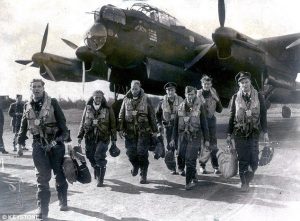 In April of 1943, during a raid on a Czechoslovakian arms factory, a British bomber crashed in Germany, going down with seven crew members on board. At the time of the crash, German soldiers recovered two of the bodies, but somehow they didn’t find or recover the bodies of the other five crewmen. It seems odd to me that they couldn’t find them, or that they somehow just chose not to bury the remaining five crewmen. Because the extensive search, following the war, produced nothing, the British Air Ministry assumed that the plane had ditched in the sea.
In April of 1943, during a raid on a Czechoslovakian arms factory, a British bomber crashed in Germany, going down with seven crew members on board. At the time of the crash, German soldiers recovered two of the bodies, but somehow they didn’t find or recover the bodies of the other five crewmen. It seems odd to me that they couldn’t find them, or that they somehow just chose not to bury the remaining five crewmen. Because the extensive search, following the war, produced nothing, the British Air Ministry assumed that the plane had ditched in the sea.
The plane, an Avro Lancaster, piloted by Alec Bone, took off from Lincolnshire, England, almost 76 years ago. Their target was a munitions plant in German-occupied Czechoslovakia. A total of 327 bombers took off that day, and 36 would never return. Bone’s plane was one of those unfortunate 36 planes. It is believed that he and his crew battled German antiaircraft fire before plunging into a field outside Laumersheim in southwestern Germany. As it searched in vain for the missing crew in the years following World War II, the British Air Ministry had no idea that German troops had already buried two of the men in Mannheim.
There was, however, one person who knew the location of the plane…Peter Menges, who was a teenager at the time he witnessed the fiery crash of the British bomber. It was a site he would ever forget, but I’m sure he assumed that the Germans had found it too, and gone to remove the bodies or any survivors. This whole  situation made me wonder why the other five men were not buried too. Upon researching this crash, I think I have discovered why. Most of us picture a plane crash with a broken plane and the bodies of the dead lying almost peacefully nearby, but most often it isn’t like that at all. When airplanes crash, they hit the ground going very fast, and the human body doesn’t handle that kind of impact very well. In fact it reacts much like an explosion, with pieces scattered all over the place. And when a plane nose dives into the ground, burying itself deep in the ground, like this one did, those body parts are often buried too.
situation made me wonder why the other five men were not buried too. Upon researching this crash, I think I have discovered why. Most of us picture a plane crash with a broken plane and the bodies of the dead lying almost peacefully nearby, but most often it isn’t like that at all. When airplanes crash, they hit the ground going very fast, and the human body doesn’t handle that kind of impact very well. In fact it reacts much like an explosion, with pieces scattered all over the place. And when a plane nose dives into the ground, burying itself deep in the ground, like this one did, those body parts are often buried too.
Menges who was 83 in 2012, when he told the tale of the fiery crash of Alec Bone’s plane. He had joined forces with Uwe Benkel, a health insurance clerk, who moonlighted as a military history researcher. Together they have helped to recover more than 100 planes. Upon learning of the exact location of the crash, a team of men used metal detectors and ground-penetrating radar to confirm the crash location near Laumersheim. Their search first unearthed the bomber’s engine and landing gear, along with hundreds of bone fragments thought to be the remains of the missing men. My guess is that because of the planes burial at the site, and the fact that most of the bodies were blown to bits at the time of the impact, the German soldiers who were at the scene to bury the bodies that day, simply could not find the other bodies.
Because no one knew where to look, the families never knew what happened for sure. They could only speculate. Now, the remains of the five British airmen have been found. Their relatives have been notified and 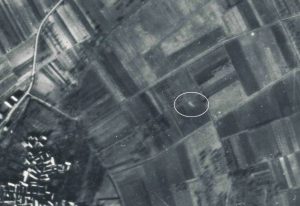 plans are being made to bury the men in a shared coffin at Germany’s Commonwealth War Graves Cemetery. Benkel told British news sources that area residents wondered why he was searching for former enemies who had bombed German cities. “It doesn’t make a difference if they are German or British,” he told The Telegraph. “They were young men who fought and died for their country for which they deserve a proper burial in a cemetery.” I agree. No matter which side of a battle a soldier fought on, he fought to the best of his or her abilities, and that deserves respect, and a proper burial. “They flew together and died together,” says Mr Benkel. “It is only right that they should stay together.”
plans are being made to bury the men in a shared coffin at Germany’s Commonwealth War Graves Cemetery. Benkel told British news sources that area residents wondered why he was searching for former enemies who had bombed German cities. “It doesn’t make a difference if they are German or British,” he told The Telegraph. “They were young men who fought and died for their country for which they deserve a proper burial in a cemetery.” I agree. No matter which side of a battle a soldier fought on, he fought to the best of his or her abilities, and that deserves respect, and a proper burial. “They flew together and died together,” says Mr Benkel. “It is only right that they should stay together.”
 As kids, most of us hear a ghost story or two, but rarely was the “ghost” a ship. Nevertheless, ghost ships do occasionally find their way into folk lore, whether they are fact or fiction. Fictitious ghost ships would have their draw, because the storyteller can elaborate as much or as little as they want, but the non-fiction version is incredible, because it is true. One such real ghost ship is the Sam Ratulangi. This ship is a modern day version of the ghost ship. Built in 2001, the ship disappeared after only eight years of service.
As kids, most of us hear a ghost story or two, but rarely was the “ghost” a ship. Nevertheless, ghost ships do occasionally find their way into folk lore, whether they are fact or fiction. Fictitious ghost ships would have their draw, because the storyteller can elaborate as much or as little as they want, but the non-fiction version is incredible, because it is true. One such real ghost ship is the Sam Ratulangi. This ship is a modern day version of the ghost ship. Built in 2001, the ship disappeared after only eight years of service.
The disappearance is not totally unusual, but not being able to locate the ship is something else all together…especially in the year 2001. If a ship sinks, someone knows just about where to look, and with satellite coverage, someone will spot a ship that didn’t sink. And this was not small boat. The Sam Ratulangi is a huge cargo ship that is 580 feet long…not something that could be easily missed in the ocean. Nevertheless, for 9 years, there was no sign of the Sam Ratulangi. Most people assumed that the ship sank back in 2001, and gave up hope of ever finding it again.
People who love the beach, know that you often find things that have washed up on shore, but no one expected a 580 foot ship to suddenly show up within sight of the beach…bottles, driftwood, even parts of a ship wreck or plane crash, but not the whole ship, and definitely not after 9 years. Nevertheless, there it was just a  couple of miles off the coast of a village in Myanmar. The ship was empty, both of cargo and of crew. It is unknown exactly what happened to the crew. The ship is enormous, and it’s pretty hard to imagine someone not seeing this drifting out on the ocean, so why had it reappeared? It was visible from the shore, but someone had to be brave enough to go onboard to check it out. The ship was seized by the Myanmar navy, until more information could be found.
couple of miles off the coast of a village in Myanmar. The ship was empty, both of cargo and of crew. It is unknown exactly what happened to the crew. The ship is enormous, and it’s pretty hard to imagine someone not seeing this drifting out on the ocean, so why had it reappeared? It was visible from the shore, but someone had to be brave enough to go onboard to check it out. The ship was seized by the Myanmar navy, until more information could be found.
The appearance of the Sam Ratulangi was a mystery, but soon there was a clue that could lead to solving it. Radar had shown there were two ships suspiciously sailing in their waters in the preceding days. They presumed the huge ghost ship was one, but where was the other? The Navy tracked down a small tugboat called Independence, and found out that it had been transporting the huge cargo ship. After questioning the 13 crew members of the Independence, it was confirmed they had been hauling the Sam Ratulangi, but had it had been cut loose following some severe weather on the sea. They claimed they were planning on dragging the ship to Bangladesh where they would sell it to ship breakers where the vessel would be stripped down, dismantled, and anything valuable would have been salvaged. Ship breaking is pretty big business these days. Modern ships are only expected to last around 25 to 30 years before they are decommissioned due to corrosion. That leaves lots of working valuable equipment onboard these ships even if the body of the ship isn’t. Shipyards allow the owners of these ships to make some money from what is otherwise an expensive hunk of metal that will soon sink to the bottom of the ocean.

Even though the Sam Ratulangi disappeared over nine years ago, this tugboat had done what no one else apparently had, and found it in the middle of the ocean. Not willing to let this colossal ship drift around aimlessly any longer, the crew of the Independence hooked their tugboat to the Sam Ratulangi and began hauling it toward Bangladesh. So, while the mystery of how the Sam Ratulangi had disappeared, and how it avoided detection for nine years, as well as what happened to it cargo and crew, will likely never be known, the mystery of how it ended up of the Myanmar shore was solved.

 While islands don’t float and can’t flip over, they are subject to one hazard that can sometimes end with their disappearance…erosion. This isn’t a situation that many of us would ever notice in our lifetime, but on one island…Holland Island, located in the Chesapeake Bay, erosion quickly became a problem. In 1910, Holland Island, considered the most populated island in the Chesapeake Bay, was thriving with 360 residents. Besides historic Victorian homes, there were many other homes, shops, a school, and a church.
While islands don’t float and can’t flip over, they are subject to one hazard that can sometimes end with their disappearance…erosion. This isn’t a situation that many of us would ever notice in our lifetime, but on one island…Holland Island, located in the Chesapeake Bay, erosion quickly became a problem. In 1910, Holland Island, considered the most populated island in the Chesapeake Bay, was thriving with 360 residents. Besides historic Victorian homes, there were many other homes, shops, a school, and a church.
Despite its historic value, erosion gradually ate away at the island which greatly concerned its residents. Erosion just doesn’t care about historic value, sentimental value, or even about people’s lives. It is just a part of nature, and if a piece of ground doesn’t have a solid base, and plenty of vegetation to keep the ground in place, wind, rain, snow, and in this case, water from the bay will eventually erode the ground to a dangerous level. That was the situation that Holland Island found itself in 1910.
In 1914, in an attempt to try to slow the erosive loss of their precious island, the residents had stones shipped in to build walls and tried to even sink ships in an attempt to slow it down, but nothing worked. Finally, giving 
 up, most of the residents tore down their homes and moved inland. Many of the buildings still remained, but the town was largely a ghost town. When a tropical storm hit in 1918, it damaged the church. By 1922, the few people who had stayed finally left after the church closed down. One man, in 1995, tried for 15 years to preserve the island, spending a fortune, all to no avail. Finally, the last house crumbled and fell, ending the fight to save Holland Island.
up, most of the residents tore down their homes and moved inland. Many of the buildings still remained, but the town was largely a ghost town. When a tropical storm hit in 1918, it damaged the church. By 1922, the few people who had stayed finally left after the church closed down. One man, in 1995, tried for 15 years to preserve the island, spending a fortune, all to no avail. Finally, the last house crumbled and fell, ending the fight to save Holland Island.

 Louis Mantin, was a French aesthete, which is a person who has a special appreciation of art and beauty. He was also, “obsessed with death and the passage of time.” He wrote in his will that he wanted to turn his home into a museum after his death. He wanted to share his love of art, and his vast collection with others. However, his Will was very explicit in the details of how this would be carried out, and some might even say it was eccentric. In his will, he made a very specific and seemingly odd request, the museum would open 100 years after his passing.
Louis Mantin, was a French aesthete, which is a person who has a special appreciation of art and beauty. He was also, “obsessed with death and the passage of time.” He wrote in his will that he wanted to turn his home into a museum after his death. He wanted to share his love of art, and his vast collection with others. However, his Will was very explicit in the details of how this would be carried out, and some might even say it was eccentric. In his will, he made a very specific and seemingly odd request, the museum would open 100 years after his passing.
Mantin died in 1905, and though he made it very clear in his will what he wanted the house to be in 100 years, he didn’t make any provisions for the upkeep of the house in the meantime. Because nothing was specifically laid out, the house eventually fell into disrepair, because it was locked up and ignored. Eventually, worms and mold settled in among his statues and in the elaborate wallpaper. After a distant relative discovered Mantin’s will and initiated an extensive renovation project, the house was finally re-opened as a museum in 2010. It was five years late, but the will was finally carried out. I suppose that it took a little time to get the house back into a condition that would allow the house to become a museum.
Townspeople and tourists can now marvel at this once hidden world, that went completely untouched for a century, admiring Mantin’s eclectic collections, as well as his flushing toilet and heated floors, true luxuries for any home back in 1905. Mantin inherited a large fortune from his father, and since he was a bachelor, with no children, he used the money to start collecting the things that he loved. He was almost obsessive about it. 
 Egyptian relics, medieval locks and keys, monkey skulls, and stuffed blowfish. Mantin had strange taste, and since he inherited the money later in life, he knew that his time with his newly acquired collection would be short. He decided that the logical solution was to turn his home into a museum. He thought people might like to know how an artistic gentleman had lived at the turn of the century. The museum might be filled with odd relics, but when you consider how rare they are, their value in the world of art would probably make them priceless.
Egyptian relics, medieval locks and keys, monkey skulls, and stuffed blowfish. Mantin had strange taste, and since he inherited the money later in life, he knew that his time with his newly acquired collection would be short. He decided that the logical solution was to turn his home into a museum. He thought people might like to know how an artistic gentleman had lived at the turn of the century. The museum might be filled with odd relics, but when you consider how rare they are, their value in the world of art would probably make them priceless.
 When a train derails, you know that there is going to be a big mess, and loss of life, or at the very least, injuries. And you would probably be right, but it would be a whole different situation, if multiple trains collided with each other. That is the exact scenario on January 17, 1929, in Aberdeen, Maryland, when two Pennsylvania Railroad passenger trains and a freight train all collided. While the collision was horrific, the loss of life was amazingly less that expected.
When a train derails, you know that there is going to be a big mess, and loss of life, or at the very least, injuries. And you would probably be right, but it would be a whole different situation, if multiple trains collided with each other. That is the exact scenario on January 17, 1929, in Aberdeen, Maryland, when two Pennsylvania Railroad passenger trains and a freight train all collided. While the collision was horrific, the loss of life was amazingly less that expected.
On that day, passenger train Number 412, bound from Washington to Philadelphia, struck the freight train, who was also northbound, just after it pulled from a siding, by Short Lane station, near Aberdeen. The freight cars toppled onto the southbound track, directly in front of express train Number 121, from New York to Washington. There was simply not time to avoid the disaster. The wreck killed four trainmen and seriously injured another. Conductors of the two passenger trains declared none of their passengers were seriously hurt. Brakeman, K. A. Klein, on the freight train, and flagman, V. W. Stewart, were both killed in the first crash; and engineer of the southbound express train, A. C. Terhune, and M. Goldstein, his fireman, were killed when their train ploughed into the wreckage.
Bodies of the two from the freight crew and of the passenger firemen were removed and taken to a morgue in Aberdeen, but the body of the express engineer was still under the engine five hours after the wreck. The workmen were prevented from recovering it by outpouring steam. Leon Sweeting, engineer of the northbound passenger train, was badly scalded and was taken to the Havre de Grace Hospital, where his condition was reported to be serious. John H. Lee, fireman on the same train, was in the hospital, suffering from shock.
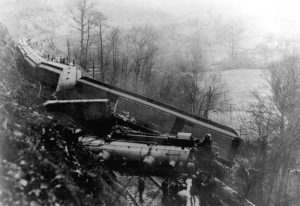
It is thought that heavy fog in the area, prevented the engineer of northbound number 412 from seeing the tail-light of the freight train right in front of him. Some passengers on the northbound and southbound trains were said to have been slightly injured, but none was reported in serious condition. The triple crash tore up about 150 yards of track and uprooted signal and telegraph poles. Trains had to be re-routed over the Baltimore and Ohio Railroad tracks, while relief trains were sent from Baltimore to Aberdeen. While this was not the worst wreck, in fatalities and injuries, I don’t recall too many, if any others involving three trains, and the experience must have been terrifying.

